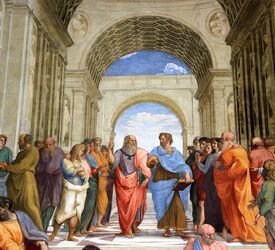Ancient Greek Art
History Of Ancient Greek Art
Classical art refers to art from ancient Greece and Rome. This means that the art would be not only beautiful and of great quality, but that it was also passed down to us from a Golden Age in the past. Both Greek and Roman art encouraged each other, and both were predictors of success for the Renaissance.
The Greeks were praised for being idealistic, creative, and spiritual, while the Romans were chastised for being too attached to the reality they saw before them. The Olympics and great works of art were created by the Greeks, while the Romans developed gladiator battles and imitated Greek art. Great temples were erected at Athens and Olympia during the Golden Age of Athens (457 B.C. to 430 B.C. ), and they were adorned with magnificent sculptures and reliefs. Hellenistic art, particularly sculpture and writing, faithfully reproduced life. The first time Greek painters identified themselves was in the eighth century B.C. when phrases like "Ergotimos created me" and "Kletis painted me" appeared on ceramics.
Ancient Greek Paintings Description:
In the Greek world, painting is on par with architecture and sculpture in terms of importance. However, for the most part, it has been lost, particularly the paintings of the classical period, which are almost entirely lost. It was always associated with architecture and sculpture, as both sculptures and architectural limbs were painted in a manner that is well known to us, as thousands of traces of paint from architectural limbs and sculptures have survived to this day, allowing us to get a complete picture of how Greek painting was done.
Greek warships were painted with pigments mixed with hot wax. This technique was later used by the Romans to create portraits. Paints made from precious stones, earth, and plants were also used by the Greeks. Until the 17th century, Aristotelian beliefs that all colors were created by mixing black and white persisted. A transexual snail with a gland that produces a fluid that turns blue when exposed to air and light provided blue to the ancient Mediterranean. Only when the glands were more male than female did they produce the substance.
The topics of ancient Greek paintings include snake-haired Medusas, centaurs, dancing females, Olympic athletes, and gods. There is also an athlete leaping from one world to the other as seen in a fifth-century B.C. Greek tomb artwork. Zesius was a Greek painter, a well-known figure in Greek art history who created several such paintings. There are various artworks that go beyond the existence of original artwork, such as Roman period painting, Greek painting's influence on Minoan paintings, and descriptions by ancient writers such as Pliny the Elder, Lucian, Athenian, Aristotle, Plato, Xenophon, and others.
Different types of unique paintings were created during the era of Greek Art such as:-
1. Minoan Painting
The Minoan period was Greece's first significant period of painting. It is associated with palace architecture and is distinguished by bright colors, realism, and delicacy in rendering form. The Minoans had a distinct painting style with shapes formed by curvilinear lines that add a feeling of liveliness to the paintings. Its color palette is based on earth tones of white, brown, red, and yellow. Black and vivid blue are also used. These color combinations create striking and rich decorations.
2. Cycladic Painting
Despite the fact that it has a strong presence of naturalistic patterns, which links it to later classical art, Cycladic painting is more philosophical than Minoan painting. Originally in the Cycladic period, color was used in pottery, and polychromy was pioneered in the Medieval Cycladic period. Here, the development of monumental painting and the experimentation of plaster occur at the same time.
3. Archaic Painting
The archaic age, like the centuries before it, is characterized by two-dimensional painting. Polygnotia colors, as well as red, black, dark, green, white, and yellow, are occasionally used without mixing colors and shades, especially in the painting of temple architectural components. The most essential aspects of the composition are its purity and clarity of shapes, as well as its underlying beat. Telephanes of Sikyona, the Corinthians Cleanthes, Aridikos, and Ekfantos, Philokles of Naukrati, and Kimon of Kleones were all-important painters throughout the archaic era.
Here are some of the most prominent representatives of classical Greek painting:-
Polygnotos made a significant contribution to the development of classical painting. He is described by Aristotle as an "excellent ethnographer." Polygnotos and Mikonas made the most significant contributions to the depiction of space and surface. Polygnotos' most significant achievement, however, was his analytical use of the colors with which nature works, particularly in its material aspect. Red, yellow, blue, and other pure and strong hues occur in the material portion of nature at a ratio of less than 1/1000. Nature's colors have to be imitated in painting. This is the well-known "Polygnotia tetrachromia" method . White, black, brick (deep red), and all its variants are among these hues (gray, brown, green, yellow, orange, pink, etc.). These hues convey a feeling of continuity and unity of accord and coherence, and so are reduced to En in global oneness (En is identified with Zeus, God, Spirit, but is also called by many other names this supreme deity of everything, as Zeno, the Kitievs tells us). As a result, it was appropriately dubbed the "four hues of Love" since love is the reduction to one principle of everything, the union of everything with the En. Many Greeks discussed it, including Olympius, who claims that the Pythagoreans, Empedocles, and Plato all discussed the same topic. Plato also claims that if the Polygnotia colors are not used while painting a face, the inherent hue of the human face is lost.
Finally, ancient Greek painting is being interpreted in new ways. Painting of temples and public constructions in general, as well as other associated art events, angiography, and so on, completes our understanding of the growth of the Greek mentality throughout time.









